#natural control pest
Text
8 Best Organic Ways to Control Pests in the Home Garden
Pests are a gardener’s worst nightmare. They damage and destroy once healthy plants within a short period, ruining all of your hard work. Many pests are resistant to conventional treatments, which is why learning organic pest prevention methods are essential.
Preventing garden pests needs to be the prime focus for all gardeners, regardless of whether you practice organic gardening. We know that…
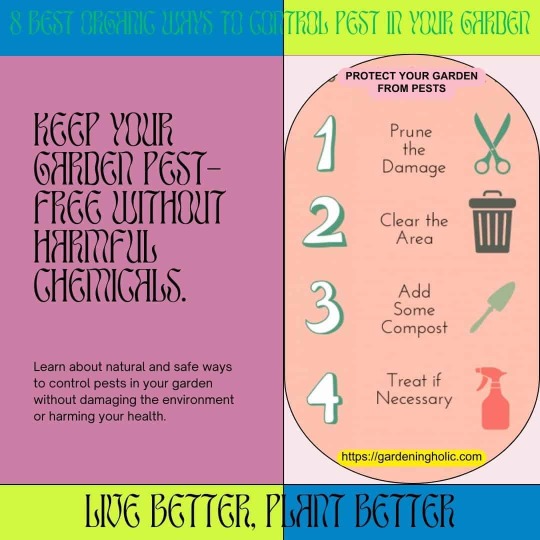
View On WordPress
#conclusion of blog post#Gardening tips#how do chemical pesticides affect plants#how to apply natural pesticide#how to keep bugs out of vegetable garden#how to use organic pesticides around children and pets#natoral ways to control pests#natural control pest#natural fertilizers#natural pest control methods#natural pesticide#organic fertilizers#organic gardening#organic pest control#organic pest control spray#resources for gardeners#ways to controlling pests in plants
0 notes
Note
spiders it is then
the anon pours a brimming glass of spiders
thanks! my house is extremely full of bugs for reasons we have yet to determine so there'll be plenty for them to eat!
#asks#we actually do keep all spiders in the house unless they're a dangerous kind#they are great natural pest control#white tips can gtfo with their flesh eating bacteria tho
12 notes
·
View notes
Text
Do you want weaver ants? Because that's how you get weaver ants!

Weaver ants use empty silk cocoons from wild silk moths as founding chambers. Empty cocoons from commercial silk production can even be used to attract queens. These ants play an important role in pest control in orchards and are desired by farmers.
(Source)
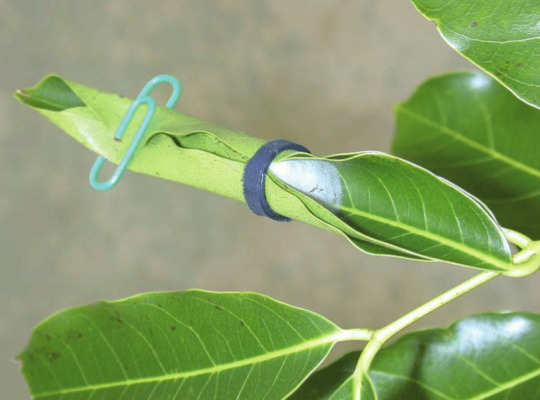
Method used by some farmers to attract weaver ant queens.
#ant#ants#weaver ants#pest control#natural pest control#antposting#myrmecology#insects#invertebrates#antkeeping#silk#silk moth#silk moths#natural silk#beneficial insects#fruit farming#fruit trees#gardening#moth#moths#entomology#bugs#lepidoptera#ant queen#queen ant#queen ants#bugblr#antblr#mothblr#farmblr
297 notes
·
View notes
Text
#good news#pesticides#natural pesticides#pest control#environmentalism#science#environment#nature#animals#roses#rose essential oil#organic#agriculture
10 notes
·
View notes
Text
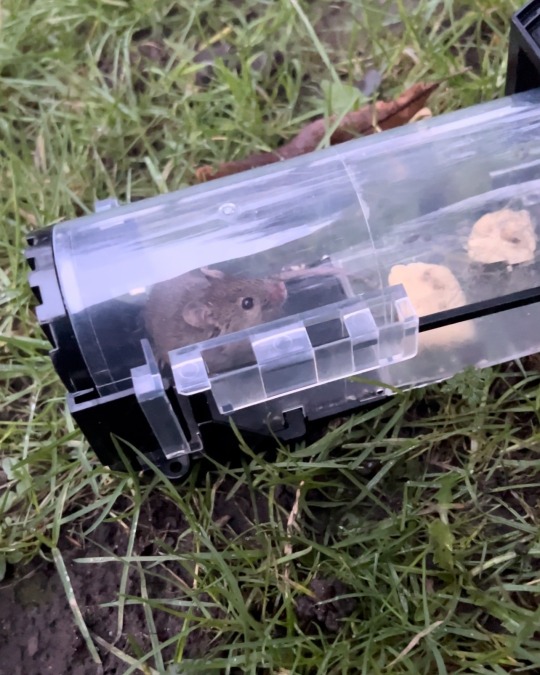

at approximately 7:45 this morning quinnen’s aunt was apprehended. she was a bit bigger than her nephew and not as hungry - she ate one piece of cheese (quinnen ate four). she also appeared more intelligent as it only took her a moment to realise that she was free whereas it took quinnen several minutes…
#the war on mice#her name was katniss#hopefully she won’t be eaten by an owl today#psa I am following the advice of the pest control man so don’t come for me for doing this Wrong ok I’m just trying to do right by nature#or whatever
16 notes
·
View notes
Text


Pink spotted lady beetle (Coleomegilla maculata) patrolling a sunflower field in Pennsylvania.
Like many lady beetles, both adults and larvae are voracious predators of aphids. They’re nice little friends to have around your garden :-)
#Coleomegilla maculata#pink spotted lady beetle#lady beetle#ladybug#bugs#nature#nature photography#biodiversity#animals#inaturalist#arthropods#entomology#insect appreciation#insects#beetles#coleoptera#bugblr#garden friends#pest control#biological control#summertime#vicious predator#aphid control#no more aphids#nom nom nom
5 notes
·
View notes
Text
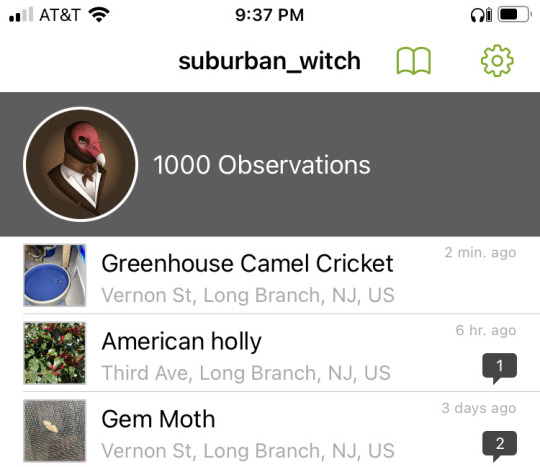
Just made my thousandth observation on iNat! It’s my cat tormenting a cave cricket!
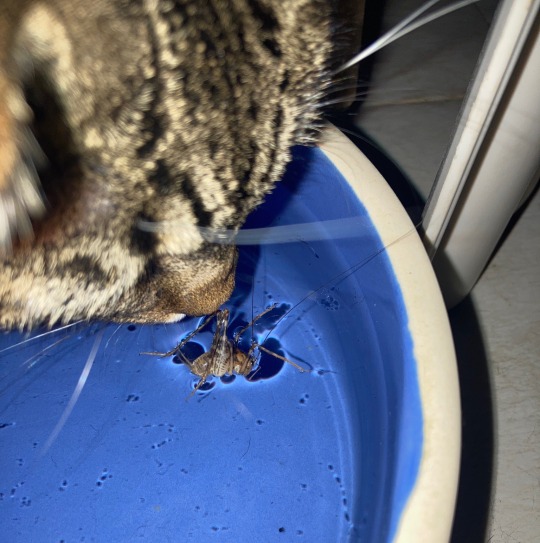
#cameronposting#inat#inaturalist#my cat’s name is Frank and he likes disemboweling crickets#it’s natural pest control#also keeps him entertained and off my table
4 notes
·
View notes
Text

A cockroach on this restaurants public health score.
#interesting#interesting facts#nature is everything#nature is weird#nature#discover#thats interesting#thats insane#thats incredible#animals#cockroaches#cockroach pest control#team cockroach#public health#health#health department#health inspectors#health inspector#woah#like woah#woahhhh#woah dude#woah :0#but woah#woah woah woah#woahg#thats crazy#what the#what the heck#irony
6 notes
·
View notes
Text
Be Kind: That Spider in Your Home Might Just Be Looking for a Date
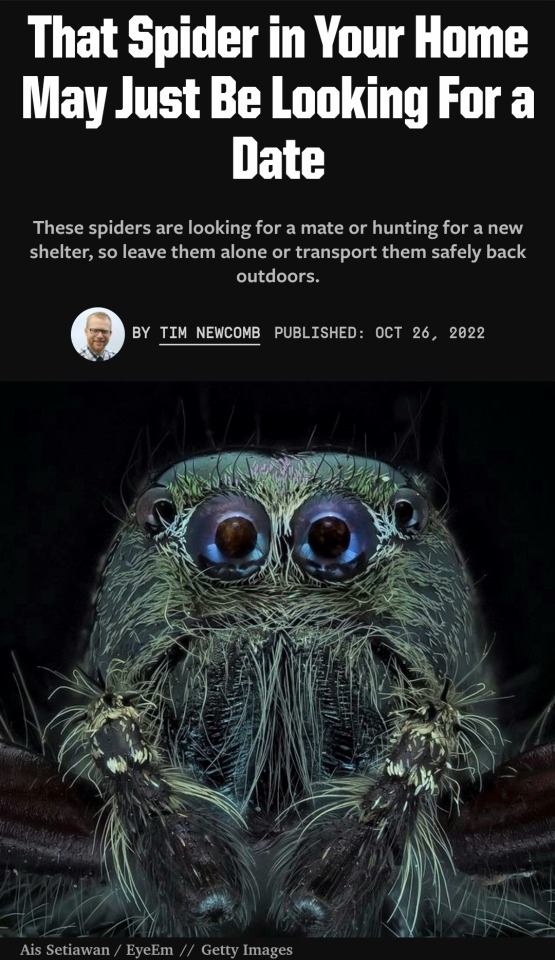
try not to freak out over discovering a spider and smash it to death. while letting it remain a roomie in trade for killing other insects might not be on everyone’s list of good deals, at least move the harmless-to-you spider back outside, experts plead
(of course, if you find a black widow, brown recluse, or tarantula, proceed with caution - personally, I don't abide brown recluses, partly because they kill other spiders)
“Once you know what you are looking at, their behaviors and benefits, spiders aren’t so scary,” says entomologist Danielson-Francois. “Some are really fascinating. You might find yourself wanting to learn more. Look up the dancing peacock spider - you won’t be disappointed.”
full story: X
19 notes
·
View notes
Text
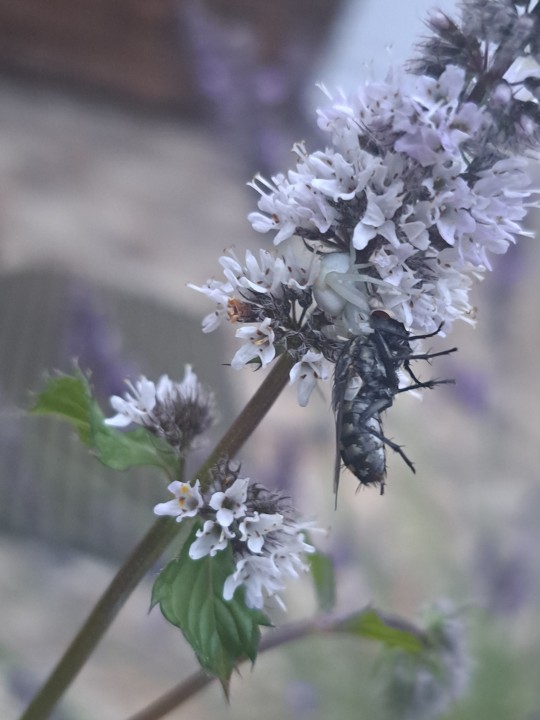
Look at this spider I found in my garden, good for her. She's gorgeous, she's independent, she's successful, she has her own apartment. I love her.
6 notes
·
View notes
Text
The family of foxes that has their kits under our shed yearly is here!! Spring has officially begun!! The kits have opened their eyes and yesterday was their first outing as far as I can tell. They are so WIGGLY. They’re climbing (and falling) all over each other and all over the place. If I could get good photos for you guys, I would. Unfortunately, my phone can only take pics of them that are the same quality as sightings of Bigfoot.
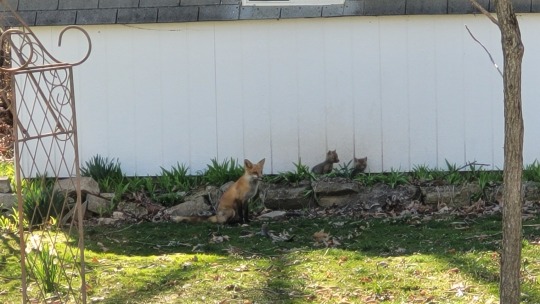

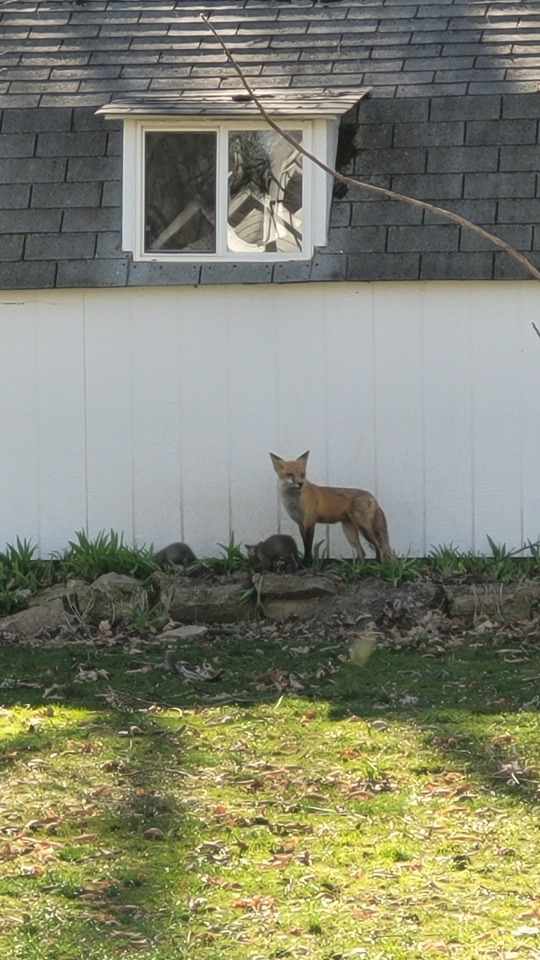
#every time the parent lies down outside the den#the babies start climbing all over them#it’s great#also the chipmunk population is gonna take a hit#which is good bc they are messing with the foundation of the house by chewing little nests into it#AND there will be fewer squirrels eating at our bird feeder#mmm free pest control + nature’s cutest babies?? hell yeah#1st and 3rd pics are my dad’s
4 notes
·
View notes
Text

TOP GARDEN PESTS--WHAT WORKED + DIDN'T
Here is some good information from a survey that Mother Earth News did to learn more about what works, and doesn't, when it comes to limiting insect damage in organic vegetable gardens. They had 1300 gardeners from across the United States respond, so is pretty good. I've included 7 of the top garden pests and info:
1) SLUGS-- took top honors as the most bothersome pest in home gardens, with 55 percent of respondents saying the slimy critters give them trouble year after year. Handpicking was highly rated as a control measure (87 percent success rate), followed by iron phosphate baits (86 percent) and diatomaceous earth (84 percent). Opinion was divided on eggshell barriers (crushed eggshells sprinkled around plants), with a 33 percent failure rate among gardeners who had tried that slug control method. An easy home remedy that received widespread support was beer traps (80 percent success rate).
2) SQUASH BUGS-- had sabotaged summer and winter squash for 51 percent of respondents, and even ducks couldn’t solve a serious squash bug problem. Most gardeners reported using handpicking as their primary defense, along with cleaning up infested plants at season’s end to interrupt the squash bug life cycle. The value of companion planting for squash bug management was a point of disagreement for respondents, with 21 percent saying it’s the best control method and 34 percent saying it doesn’t help.
Of the gardeners who had tried it, 79 percent said spraying neem on egg clusters and juvenile squash bugs is helpful. About 74 percent of row cover users found them useful in managing squash bugs.
3) APHIDS-- were on the watch list of 50 percent of respondents, but the success rates of various control techniques were quite high. Active interventions, including pruning off the affected plant parts and applying insecticidal soap, were reported effective, but so were more passive methods, such as attracting beneficial insects by planting flowers and herbs. Several readers noted the ability of sweet alyssum and other flowers to attract hoverflies, which eat aphids. “We attract a lot of beneficials by planting carefree flowers in the vegetable garden, including calendula, borage, zinnias, cosmos and nasturtiums” (Midwest, more than 20 years of experience).
4) SQUASH VINE BORERS-- had caused problems for 47 percent of the survey respondents. The best reported control methods were crop rotation and growing resistant varieties ofCucurbita moschata, which includes butternut squash and a few varieties of pumpkin. TheC. moschata varieties are borer-resistant because they have solid stems. Interestingly, if you’re attempting to fend off squash vine borers, lanky, long-vined, open-pollinated varieties of summer squash (zucchini and yellow crookneck, for example) may fare better than hybrids, because OP varieties are more likely to develop supplemental roots where the vines touch the ground.
Many gardeners dump soil over these places, so if squash vine borers attack a plant’s main stem, the plant can keep on growing from its backup root system.
5) JAPANESE BEETLES-- Forty-six percent of respondents reported working in the unwelcome company of Japanese beetles, with handpicking being the most popular control method. Some gardeners grow trap crops of raspberries or other fruits to keep Japanese beetles away from plants. Several commonly used interventions — garlic-pepper spray, milky spore disease, pheromone traps and row covers — had high failure rates.
6) TOMATO HORNWORMS-- were of concern to 42 percent of our survey respondents. Bt and handpicking were the preferred control methods, and several folks commented that tomato hornworms are among the easiest garden pests to handpick (probably because they’re large, easy to spot and produce a telltale, pebbly trail). Many gardeners reported seeing tomato hornworms often covered with rice-like cocoons of parasitic braconid wasps. “I had a lot of tomato hornworms this year, but the wasps took them out! Just like in the photos online and in bug books!” (Mid-Atlantic, more than 20 years of experience). Gardeners named zinnias and borage as good companion plants for reducing hornworm problems.
7) CUTWORMS-- were a concern for 41 percent of respondents, and effectiveness ratings for using rigid collars (made from plastic drinking cups or cardboard tissue rolls) to protect young seedlings from damage were amazingly high (93 percent effectiveness rating). A common practice to reduce cutworm damage is to cultivate the soil’s surface once or twice before planting and hope robins and other bug-eating birds will swoop in to gather the juicy cutworms. Big, sturdy seedlings are naturally resistant to cutworms, so many gardeners said they set out seedlings a bit late to avoid cutworm damage.
#garden#gardening#homesteading#junko on the farm#pests#pest control#garden pests#organic#bugs#natural#solution
4 notes
·
View notes
Text
A piece of bird poo? Look again...
One of my favourite discoveries in the garden, this year has been the Bird Dropping Spider (Celaenia excavata) that has made it’s home on our White Sapote.
Looks like bird poo to me!
I discovered her by accident when I was cleaning a few leaves from bird poo while getting ready for the Mannum Gardening Club to visit. I’m assuming she’s a her because of the size of the body. I could be wrong but…
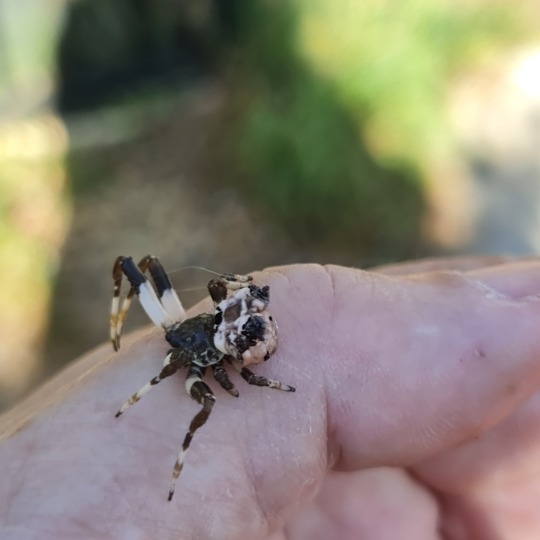
View On WordPress
2 notes
·
View notes
Text
time to buy myself some pretty drakes and lie about being able to make money selling hatching eggs
#duckposting#though i wonder if i actually can get a 'natural pest control' thing going just renting out ducks to eat grasshoppers
6 notes
·
View notes
Text
Every night at least two frogs hang out on my window. I've seen as many as 7. It is the most pure thing.
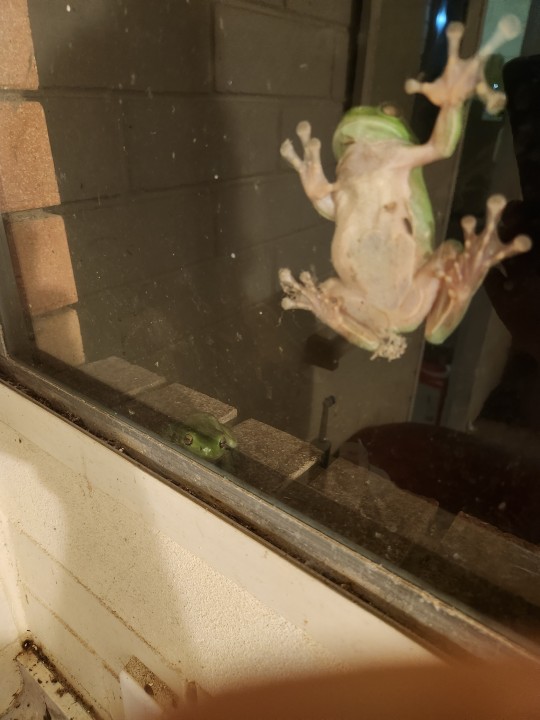
#its only green tree frog's that hang out on the window#the spotted marsh frogs prefer the pond#theres gecko's too#my house is surrounded by tiny bug eating friends :)#frog#gecko#green tree frogs#spotted marsh frogs#amphibians#natural pest control
3 notes
·
View notes
Text
Hate it whenever people say "[insect] serves no purpose so kill them all" like sorry what "purpose" are you talking about. Not every living creature on earth has to earn it's right to exist by being useful to humans plus I bet if you put in an ounce of research you will find that they actually have their place in the ecosystem and we probably do benefit from their existence in some way. Same goes for plants btw. Weeds aren't a real thing. Grow up.
#like just saw someone say this about hornets. hornets!!! the pollinator and and natural pest controller!!!!#just because we can't get honey from them doesn't mean there useless like gtfo#alllel posts#nature#wasps#hornets#insects
4 notes
·
View notes